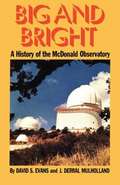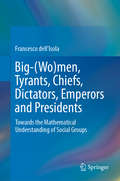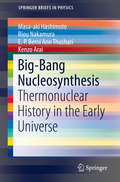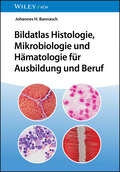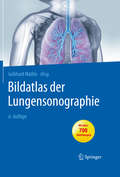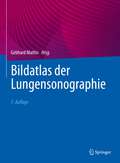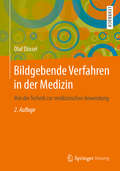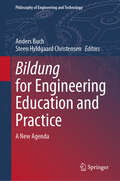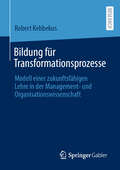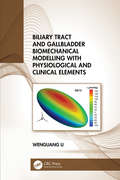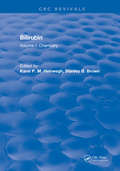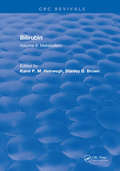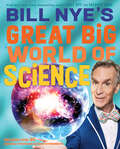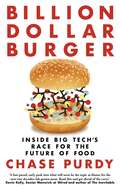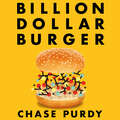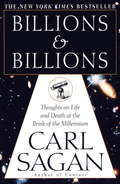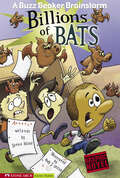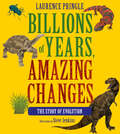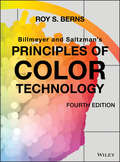- Table View
- List View
Big and Bright: A History of the McDonald Observatory
by David S. Evans J. Derral MulhollandBy day, every year over 40,000 visitors pour in. Across the Rio Grande, a hundred miles away, Mexican mountaineers use the white domes as landmarks. By night, perched almost 7,000 feet above the sleeping, earthbound world, astronomers probe the secrets of the night sky. This is the University of Texas McDonald Observatory, one of the world's largest university-operated astronomical installations. Big and Bright: A History of the McDonald Observatory is the story of a remarkable collaboration between two major universities, one a prestigious private school, the other a growing southwestern state institution. The University of Chicago had astronomers, but its Yerkes Observatory was aging and underfunded; the University of Texas had money for an observatory but no working astronomer to staff it. Out of their mutual need, they formed a thirty-year compact for a joint venture. Unusual in its day, the Yerkes-McDonald connection presaged the future. In this arrangement, one can see some of the beginnings of today's consortium "big science. " Now the McDonald Observatory's early history can be put in proper perspective. Blessed with a gifted and driving founding director, the world's (then) second-largest telescope, and an isolation that permitted it to be virtually the only major astronomical observatory that continued operations throughout World War II, the staff of McDonald Observatory helped lay the foundations of modern astrophysics during the 1940s. For over a decade after the war, a lonely mountaintop in West Texas was the mecca that drew nearly all the most important astronomers from all over the world. Based on personal reminiscences and archival material, as well as published historical sources, Big and Bright is one of the few histories of a major observatory, unique in its focus on the human side of the story.
Big and Small, Room for All
by Jo Ellen BogartA captivating look at how a child, fits into the great, big universe around us.“Big sky, big sky, what is bigger than the sky?”In this clever concept book for young readers, award-winning author Jo Ellen Bogart explores the size of animate and inanimate objects and their place in the universe. She introduces children to the concept of “we” — that humans are a big part of the world, but a small part of existence.In the vastness of the universe, with galaxies swirling through space, the book begins with simple words printed on the darkness. Moving closer to our world, we see the solar system, our sun at the center. Closer still, we see the huge ball of fire, which is the sun, and the third planet out from it — our blue Earth. From Earth looming huge on the page, young readers view smaller and smaller objects, from mountain to tree to man to child to kitten to mouse to flea to microscopic beings, amazing in their complexity.Accompanied by artist Gillian Newland’s lavish watercolor paintings, Big and Small, Room for All places the immensity and wonder of space in perspective so young readers comprehend they are part of creation, but a small part of all that exists.
Big as a Giant Snail (The World of Weird Animals)
by Jess KeatingGo big or go home! Meet the biggest weirdos on Earth in this colosally cool collection from the team that brought you Pink Is For Blobfish.It's a big wide world, full of critters that are larger than life! Sure, there are the usual suspects: blue whales, polar bears, elephant seals . . . but others will take you by surprise. The giant snail, for instance, or the ginormous Atlas moth. Like Pink Is for Blobfish and Cute as an Axolotl, Big as a Giant Snail will cover a wide variety of species, while subtly delving into misconceptions and stereotypes associated with size. Best of all? These tall tales are totally true! "Awe-inspiring... This work fits into so many lessons, from endangered species to climate change and habitat preservation, that it&’s hard to imagine a collection that would not benefit from having it on its shelves." —School Library Journal
Big-(Wo)men, Tyrants, Chiefs, Dictators, Emperors and Presidents: Towards the Mathematical Understanding of Social Groups
by Francesco dell'IsolaThis book highlights mathematical ideas to help explain a number of important aspects of the dynamics of social groups. These ideas are similar to those used to describe the behaviour of Lagrangian mechanical systems, and as such this book appeals to anyone wanting to gain an understanding of the intrinsic unity of natural phenomena.
Big-Bang Nucleosynthesis: Thermonuclear History in the Early Universe (SpringerBriefs in Physics)
by Masa-Aki Hashimoto Riou Nakamura Kenzo Arai E. P. ThushariThe book reviews theories of nucleosynthesis in big-bang cosmology. It introduces the standard model of cosmology, astronuclear reactions, numerical techniques for nucleosynethsis, and describes in detail the theories that go beyond the standard models, enabling readers to grasp the physics of big-bang nucleosynthesis on the basis of cosmology, general relativity and nuclear physics. In addition, the authors provide insights into the theoretical constrains required by observations. As a consequence, readers find out that big-bang nucleosynthesis still has windows opened to another cosmology. Although the book focuses on highly advanced topics, it is concisely written and mathematical derivations are explained step-by-step, making it accessible to graduate readers. Thus it is a short monograph appealing to a variety of readers interested in nucleosynthesis of big-bang cosmology.
Bildatlas Histologie, Mikrobiologie und Hämatologie für Ausbildung und Beruf
by Johannes H. BannaschDie clevere Alternative zu teuren Spezialwerken: Alle drei medizinischen Mikroskopiefächer in einem handlichen Atlas Die mikroskopische Darstellung und Bestimmung von Zellen und Geweben ist ein integraler Bestandteil zahlreicher medizinischer Ausbildungsgänge, vom Laboranten zum technischen Assistenten bis hin zum Humanmediziner. Anhand von mehr als 200 vierfarbigen Abbildungen dokumentiert der Autor die wichtigsten Lehr- und Lerninhalte in den drei „Mikroskopiefächern“ Histologie, Mikrobiologie und Hämatologie. Die Auswahl der Themen orientiert sich an den Anforderungen für die Ausbildung als MTA bzw. MTLA. In der Histologie werden alle wichtigen Organe und Organsysteme mithilfe unterschiedlicher Färbetechniken dokumentiert. In der Mikrobiologie sind Nachweise der häufigsten humanpathogenen Keime gezeigt, sowohl im Ursprungsmaterial als auch nach Vermehrung auf Agarplatten. In der Hämatologie werden die wichtigsten krankheitsbedingten Blutbilder erläutert und mit nicht-krankheitsbedingten Veränderungen verglichen. Alles in einem: Dieser Atlas vereint die wichtigsten Inhalte aus den drei Mikroskopiefächern Hämatologie, Histologie, Mikrobiologie und erspart so die Anschaffung von Spezialwerken. Absolut praxistauglich: Erklärt detailliert den Ablauf der Probenherstellung, von der Entnahme bis hin zum mikroskopierfähigen Präparat. Detailreiche Bilder: Mehr als 200 eigens aufgenommene großformatige Farbfotos aus dem Präparatefundus der MTA-Schule Hamburg und aus der universitären Pathologie zeigen Gewebeschnitte, Blutbilder und andere mikroskopische Präparate. Der Bildatlas Histologie, Mikrobiologie und Hämatologie ist bestens geeignet für die Ausbildung als MTA und MTLA, für medizinische Laborant*innen und für Studierende der Medizin.
Bildatlas der Lungensonographie
by Gebhard MathisDAS Standardwerk für Lungen- und Pleurasonographie für Internisten, Pneumologen, Radiologen, Thoraxchirurgen, Intensiv- und Notfallmediziner, Pädiater. State-of-the-art von den Meinungsbildnern des deutschsprachigen Raums. Der Schallkopf als Stethoskop: Kleine, tragbare Ultraschallgeräte, die immer dabei sind, werden zum unverzichtbaren Tool und ermöglichen die ,,Bedside-Sonographie". Moderne Technik liefert Bilder höchster Qualität - Kosten sparend, ohne Belastung für den Patienten. Grundlagen Indikationen, Gerätetechnik, Bildartefakte, Untersuchungsgänge Diagnostik, Befundung, Verlaufskontrolle Ausführliche Darstellung der bildgebenden Stufendiagnostik Entscheidungsfindung ,,Vom Symptom zur Diagnose" Mit Praxistipps und Hinweisen auf Fehlerquellen Inklusive detaillierter Darstellung der Ultraschalluntersuchung des Mediastinums (endobronchialer Schall, transösophagealer Schall) Inklusive Kontrastunterstützte Sonographie (KUS) Umfangreiches einzigartiges Bildmaterial Hochwertige Abbildungen nach neuester Technik NEU u. a. Lungensonographie in der Notfallmedizin z. B. in der Differentialdiagnose der Luftnot, Pneumothorax u. a. Interstitielles Syndrom Bildmaterial und Text umfassend überarbeitet und aktualisiert Einbeziehung der neuesten Studienergebnisse, Metaanalysen und Literatur Herausge ber Professor Dr. Gebhard Mathis, Rankweil, Österreich
Bildatlas der Lungensonographie
by Gebhard MathisDAS Standardwerk für Lungen- und Pleurasonographie für Internisten, Pneumologen, Radiologen, Thoraxchirurgen, Intensiv- und Notfallmediziner, Pädiater. State-of-the-art von den Meinungsbildnern des deutschsprachigen Raums. Der Schallkopf als Stethoskop: Kleine, tragbare Ultraschallgeräte, die immer dabei sind, werden zum unverzichtbaren Tool und ermöglichen die „Bedside-Sonographie“. Moderne Technik liefert Bilder höchster Qualität - Kosten sparend, ohne Belastung für den Patienten.GrundlagenIndikationen, Gerätetechnik, Bildartefakte, UntersuchungsgängeDiagnostik, Befundung, VerlaufskontrolleAusführliche Darstellung der bildgebenden StufendiagnostikEntscheidungsfindung „Vom Symptom zur Diagnose“Mit Praxistipps und Hinweisen auf FehlerquellenInklusive detaillierter Darstellung der Ultraschalluntersuchung des Mediastinums (endobronchialer Schall, transösophagealer Schall)Inklusive Kontrastunterstützte Sonographie (KUS)Lungensonographie in der Notfallmedizin z.B. in der Differentialdiagnose der Luftnot, PneumothoraxEinbeziehung der neuesten Studienergebnisse, Metaanalysen und LiteraturUmfangreiches einzigartiges BildmaterialHochwertige Abbildungen nach neuester Technik
Bildgebende Verfahren in der Medizin: Von der Technik zur medizinischen Anwendung
by Olaf DösselDieses erfolgreiche Standardwerk beschreibt s#65533;mtliche bildgebenden Verfahren von der R#65533;ntgentechnik #65533;ber den Ultraschall bis zu den Methoden der Tomographie. Es werden sowohl die technischen Grundlagen als auch die medizinischen Anwendungen erl#65533;utert. Das Lehrbuch zeichnet sich aus durch eine verst#65533;ndliche Darstellung, zahlreiche Illustrationen der grundlegenden Prinzipien sowie durch Bilder von den verschiedenen Modalit#65533;ten und von den Ger#65533;ten. Die 2. Auflage wurde aktualisiert und enth#65533;lt neue Trends und Entwicklungen, insbesondere beim R#65533;ntgen und Ultraschall. Kapitel #65533;ber Magnetic Particle Imaging (MPI) wurden hinzugef#65533;gt.
Bildgebung Lymphologie: Sonographie, Lymphangiographie, MR und Nuklearmedizin
by Wolfgang Justus BrauerBildgebung bei Erkrankungen des Lymphgefäßsystems - Das Wichtigste für alle Ärztinnen und ÄrzteErkrankungen des Lymphgefäßsystems sind häufig, werden jedoch oft nicht erkannt oder in Ihrer Tragweite unterschätzt. Kenntnisse über die diagnostischen Möglichkeiten mittels bildgebender Verfahren sind selbst bei lymphologisch orientierten, aber auch in der Tumornachsorge tätigen Ärztinnen und Ärzten oft nur eingeschränkt vorhanden.Umfassend, praxisbezogen und anwendungsorientiert stellen die Autoren die bildgebenden diagnostischen Verfahren des Lymphgefäßsystems, deren technische Durchführung, Möglichkeiten und Grenzen dar. Das Buch wendet sich an Fachärztinnen und Ärzte sowie Ärztinnen und Ärzte in Ausbildung, zu deren Fachrichtung Erkrankungen des Lymphgefäßsystems gehören, also Allgemeinmediziner, Angiologen, Chirurgen, Dermatologen, Internisten, Lymphologen, Phlebologen. Aus dem Inhalt:Funktionelle Anatomie des LymphgefäßsystemsLymphszintigraphie/FunktionslymphszintigraphieMagnetresonanz-LymphangiographieIndirekte Lymphangiographie und Direkte Lymphographie Sonographische Diagnostik der Lymphknoten und LymphgefäßeSonographische Befunde bei Ödemen und Lymphödemen und anderen interstitiellen FlüssigkeitseinlagerungenZystische lymphatische Malformation (LM) - Diagnose und TherapieIndocyaningrün (ICG)-Lymphographie in der LymphchirurgieNuklearmedizinische Wächterlymphknoten-DiagnostikPositronenemissionscomputertomografie (PET) - Detektion pathologischer LymphknotenFluoreszenz-Mikrolymphographie - eine wichtige Methode zur Frühdiagnose des Lymphödems
Bildung for Engineering Education and Practice: A New Agenda (Philosophy of Engineering and Technology #49)
by Steen Hyldgaard Christensen Anders BuchUsing the concept of Bildung as a framework, which in late capitalism/postmodernity may be perceived to include critical knowledge, value consciousness, ethics, and social responsibility (including sustainability), this project aims to investigate the underlying aspirations, structures, and dynamics of change taking place in engineering education and practice through conversations between engineering, social sciences, and the humanities. Calling upon the spirit of philosophers on Bildung such as John Dewey, Jürgen Habermas and contemporaries, the focus of the present project is on broadening engineering education initiatives and practice that follow normative understandings of Bildung. This volume appeals to researchers and students working in philosophy, engineering, and education.
Bildung für Transformationsprozesse: Modell einer zukunftsfähigen Lehre in der Management- und Organisationswissenschaft
by Robert KebbekusUnternehmen und Gesellschaften stehen vor dynamischen Herausforderungen wie Klimawandel, KI, demografischen Umbrüchen und geopolitischen Konflikten. Um langfristig erfolgreich zu sein werden Fachkräfte mit Metakompetenzen benötigt, die Transformationsprozesse in sozialen Systemen aussichtsreich realisieren. Universitäten könnten solche Kompetenzen fördern, doch das aktuelle Bildungssystem orientiert sich primär an Arbeitsmarktbedürfnissen, ein pluraler Ansatz in der universitären Bildung mit Fokus aus gesellschaftlichen Bedürfnissen fehlt bisher völlig. Dieses Buch liefert mit seinem Beitrag im Bereich der sozio-ökonomischen Bildung und Kompetenzentwicklung für Transformationsprozesse ein Modell für zukunftsfähige Lehre in der Management- und Organisationswissenschaft. Grundlage dafür sind die Verknüpfung des Capability Approach der Theorie sozialer Systeme, sowie der Lernforschung. Der Capability Approach bildet dabei mit seiner Forderung nach kontextueller Förderung von Menschen eine Brücke zwischen der Theorie sozialer Systeme und der Lerntheorie. Mit einem pluralen Ansatz werden so wesentliche Beiträge geliefert, die eine Weiterentwicklung und Modulation der universitären Lehre ermöglichen.
Bildungs- und Berufsvorstellungen von Bachelorabsolventen und -absolventinnen: Empirische Analysen anhand von Befragungs- und Registerdaten (Lernweltforschung #38)
by Anja Eder Sarah Aldrian Katharina DemanIm Zentrum des Sammelbands steht der Bildungsübergang von Bachelor- in Masterstudien, welcher durch die Studienstrukturreform des europäischen Hochschulraums seit über 20 Jahren besteht. Trotz des Ausmaßes der Umstellung in die dreigliedrige Studienarchitektur wurde dieser Übertrittsphase insbesondere im Hinblick auf die Situation der Hochschulen in Österreich bislang wenig Aufmerksamkeit gewidmet. Um der Komplexität der Entscheidungssituation beim Übertritt vom Bachelor zum Master Rechnung zu tragen, werden verschiedene Gruppen von Akteur*innen, deren institutionelle Einbettung und die gesellschaftlichen Rahmenbedingungen sowie geltende Normen in den Blick genommen. Dazu präsentiert der Band neue Erkenntnisse aus Befragungen mit Studierenden und Studienverantwortlichen an der Universität Graz, mit Fokus auf die Situation in den Geisteswissenschaften, sowie aus der österreichischen Registerdatenforschung. Die Befunde liefern, ergänzend zur Hochschulstatistik, ein tieferes Verständnis der Bildungs- und Berufsvorstellungen und -wege von Bachelorabsolvent*innen. Vor dem Hintergrund teils rückläufiger Studierendenzahlen, dem Wettbewerb um Studierende sowie aktuellen bildungspolitischen Diskussionen füllt der Band ein Forschungsdesiderat und bietet Hochschulverantwortlichen eine empirisch fundierte Grundlage.
Biliary Tract and Gallbladder Biomechanical Modelling with Physiological and Clinical Elements
by Wenguang LiGallstone and other diseases of the biliary tract affect more than around 20% of the adult population. The complications of gallstones, acute pancreatitis and obstructive jaundice, can be lethal. This is the first book to systematically treat biliary tract and gallbladder modelling with physiological and clinical information in a biomechanical context. The book provides readers with detailed biomechanical modelling procedures for the biliary tract and gallbladder based on physiological information, clinical observations and experimental data and with the results properly interpreted in terms of clinical diagnosis and with biomechanical mechanisms for biliary diseases. The text can be used as a reference book for university undergraduates, postgraduates and professional researchers in applied mathematics, biomechanics, biomechanical engineering and biomedical engineering, as well as related surgeons.
Bilirubin: Volume I: Chemistry
by Karel P. HeirweghThe book appears in two volumes, the first dealing primarily with chemical and structural aspects, and the second with metabolic aspects. The purpose is not only to review recent work on chemical and physiological aspects of bilirubin scructure and metabolism, but also to emphasize the importance of methodological advances and their potential in future studies.
Bilirubin: Volume II: Metabolism
by Karel P. HeirweghThe book appears in two volumes, the first dealing primarily with chemical and structural aspects, and the second with metabolic aspects. The purpose is not only to review recent work on chemical and physiological aspects of bilirubin scructure and metabolism, but also to emphasize the importance of methodological advances and their potential in future studies.
Bill Nye's Great Big World Of Science
by Bill Nye Gregory MoneScience educator, TV host, and New York Times-bestselling author Bill Nye is on a mission to help kids understand and appreciate the science that makes our world work. Featuring a range of subjects--physics, chemistry, geology, biology, astronomy, global warming, and more--this profusely illustrated book covers the basic principles of each science, key discoveries, recent revolutionary advances, and the problems that science still needs to solve for our Earth. Nye and coauthor Gregory Mone present the most difficult theories and facts in an easy-to-comprehend, humorous way. They interviewed numerous specialists from around the world, in each of the fields discussed, whose insights are included throughout. Also included are experiments kids can do themselves to bring science to life! Features photographs, illustrations, diagrams, glossary, bibliography, and index.
Bill Nye's Great Big World of Science
by Bill Nye Gregory MoneWith photos, experiments, and more, this “appealing and highly informative” science book from the beloved TV host is “a winner” (School Library Journal).Science educator, TV host, and New York Times–bestselling author Bill Nye is on a mission to help young people understand and appreciate the science that makes our world work. Featuring a range of subjects—physics, chemistry, geology, biology, astronomy, global warming, and more—this profusely illustrated book covers the basic principles of each science, key discoveries, recent revolutionary advances, and the problems that science still needs to solve for our Earth. Nye and coauthor Gregory Mone present the most difficult theories and facts in an easy-to-comprehend, humorous way. They interviewed numerous specialists from around the world, in each of the fields discussed, whose insights are included throughout. Also included are experiments kids can do themselves to bring science to life! “Wordplay and wry wit put extra fun into a trove of fundamental knowledge.” —Kirkus Reviews (starred review) Includes photographs, illustrations, diagrams, glossary, bibliography, and index
Billion Dollar Burger: Inside Big Tech's Race for the Future of Food
by Chase PurdyA fast-paced, gripping insider account of the entrepreneurs and renegades racing to bring lab-grown meat to the world.The trillion-dollar meat industry is one of our greatest environmental hazards; it pollutes more than all the world's fossil-fuel-powered cars. Global animal agriculture is responsible for deforestation, soil erosion and more emissions than air travel, paper mills and coal mining combined. It also depends on the slaughter of more than 60 billion animals per year, a number that is only increasing as the global appetite for meat swells. The whole world seems to be sleepwalking into a food crisis. But a band of doctors, scientists, activists and entrepreneurs have been racing to end animal agriculture as we know it, hoping to fulfill a dream of creating meat without ever having to kill an animal. This is the story of a group of seven vegans quietly working to solve one the most pressing issues we face today, creating the biggest upheaval to the food business in decades along the way. In Billion Dollar Burger, Chase Purdy explores the companies at the cutting edge of the nascent food technology sector, from polarizing activist-turned-tech CEO Josh Tetrick to lobbyists and regulators on both sides of the issue. Billion Dollar Burger follows the people fighting to upend our food system as they butt up against the entrenched interests fighting viciously to stop them. It will take readers on a truly global journey from Silicon Valley to China, by way of Israel and the UK.The stakes are monumentally high: cell-cultured meat is the best hope for sustainable food production, a key to fighting climate change, a gold mine for the companies that make it happen and an existential threat for the farmers and meatpackers that make our meat today.
Billion Dollar Burger: Inside Big Tech's Race for the Future of Food
by Chase PurdyA fast-paced, gripping insider account of the entrepreneurs and renegades racing to bring lab-grown meat to the world.The trillion-dollar meat industry is one of our greatest environmental hazards; it pollutes more than all the world's fossil-fuel-powered cars. Global animal agriculture is responsible for deforestation, soil erosion and more emissions than air travel, paper mills and coal mining combined. It also depends on the slaughter of more than 60 billion animals per year, a number that is only increasing as the global appetite for meat swells. The whole world seems to be sleepwalking into a food crisis. But a band of doctors, scientists, activists and entrepreneurs have been racing to end animal agriculture as we know it, hoping to fulfill a dream of creating meat without ever having to kill an animal. This is the story of a group of seven vegans quietly working to solve one the most pressing issues we face today, creating the biggest upheaval to the food business in decades along the way. In Billion Dollar Burger, Chase Purdy explores the companies at the cutting edge of the nascent food technology sector, from polarizing activist-turned-tech CEO Josh Tetrick to lobbyists and regulators on both sides of the issue. Billion Dollar Burger follows the people fighting to upend our food system as they butt up against the entrenched interests fighting viciously to stop them. It will take readers on a truly global journey from Silicon Valley to China, by way of Israel and the UK.The stakes are monumentally high: cell-cultured meat is the best hope for sustainable food production, a key to fighting climate change, a gold mine for the companies that make it happen and an existential threat for the farmers and meatpackers that make our meat today.
Billion-Dollar Fish: The Untold Story of Alaska Pollock
by Kevin M. BaileyAlaska pollock is everywhere. If you’re eating fish but you don’t know what kind it is, it’s almost certainly pollock. Prized for its generic fish taste, pollock masquerades as crab meat in california rolls and seafood salads, and it feeds millions as fish sticks in school cafeterias and Filet-O-Fish sandwiches at McDonald’s. That ubiquity has made pollock the most lucrative fish harvest in America—the fishery in the United States alone has an annual value of over one billion dollars. But even as the money rolls in, pollock is in trouble: in the last few years, the pollock population has declined by more than half, and some scientists are predicting the fishery’s eventual collapse. In Billion-Dollar Fish, Kevin M. Bailey combines his years of firsthand pollock research with a remarkable talent for storytelling to offer the first natural history of Alaska pollock. Crucial to understanding the pollock fishery, he shows, is recognizing what aspects of its natural history make pollock so very desirable to fish, while at the same time making it resilient, yet highly vulnerable to overfishing. Bailey delves into the science, politics, and economics surrounding Alaska pollock in the Bering Sea, detailing the development of the fishery, the various political machinations that have led to its current management, and, perhaps most important, its impending demise. He approaches his subject from multiple angles, bringing in the perspectives of fishermen, politicians, environmentalists, and biologists, and drawing on revealing interviews with players who range from Greenpeace activists to fishing industry lawyers. Seamlessly weaving the biology and ecology of pollock with the history and politics of the fishery, as well as Bailey’s own often raucous tales about life at sea, Billion-Dollar Fish is a book for every person interested in the troubled relationship between fish and humans, from the depths of the sea to the dinner plate.
Billions & Billions: Thoughts on Life and Death at the Brink of the Millennium (Americana Ser.)
by Carl SaganIn the final book of his astonishing career, Carl Sagan brilliantly examines the burning questions of our lives, our world, and the universe around us. These luminous, entertaining essays travel both the vastness of the cosmos and the intimacy of the human mind, posing such fascinating questions as how did the universe originate and how will it end, and how can we meld science and compassion to meet the challenges of the coming century? Here, too, is a rare, private glimpse of Sagan's thoughts about love, death, and God as he struggled with fatal disease. Ever forward-looking and vibrant with the sparkle of his unquenchable curiosity, Billions & Billions is a testament to one of the great scientific minds of our day.From the Trade Paperback edition.
Billions of Bats: A Buzz Beaker Brainstorm (A Buzz Beaker Brainstorm)
by Scott NickelWhen Sarah uses her pet bat to help show off her new cosmic copy machine to the class, something horrible goes wrong resulting in Buzz Beaker and Sarah having to save the day. Written in graphic-novel format.
Billions of Years, Amazing Changes: The Story of Evolution
by Laurence PringleThis highly engaging exploration of the concept of evolution lays out the history of life on earth—what we know and how we know it. Ever since Charles Darwin revealed his landmark ideas about evolution in 1859, new findings have confirmed, expanded, and refined his concepts. This ALSC Notable children's book brings together the pillars of evidence that support our understanding of evolution. In addition to stunning illustrations, more than fifty photographs capture natural marvels, including awe-inspiring fossils, life forms, and geological wonders. The result is a full and clear account of the monumental evidence supporting the modern view of evolution.
Billmeyer and Saltzman's Principles of Color Technology
by Roy S. BernsThis book offers detailed coverage of color, colorants, the coloring of materials, and reproducing the color of materials through imaging. It combines the clarity and ease of earlier editions with significant updates about the advancement in color theory and technology. Provides guidance for how to use color measurement instrumentation, make a visual assessment, set a visual tolerance, and select a formulation Supplements material with numerical examples, graphs, and illustrations that clarify and explain complex subjects Expands coverage of topics including spatial vision, solid-state lighting, cameras and spectrophotometers, and translucent materials
